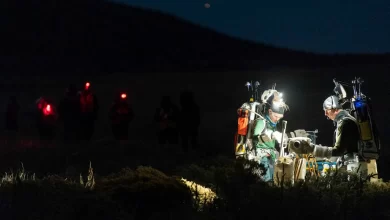
Covid-19: The story of the epidemic that has ravaged the world
“كوفيد-١٩” .. قصة الوباء الذي عصف بالعالم
Anadolu – WGOQatar Translations
Ankara: When China reported to the World Health Organization (WHO) of a “mysterious, unknown respiratory disease” that appeared in Wuhan City, Hubei Province, the last day of 2019, the world was having the first look at the coronavirus. Initially, Corona was presented as a local or regional epidemic spreading in and around China, but it quickly crossed the line and turned into a public health-threatening pandemic that spread around the world. Over the past year, the world has followed with great anticipation and attention all developments related to Covid-19, and issues related to “epidemic control measures” have become a major business agenda for all countries.
For the first time, people who had visited a seafood market in Wuhan, China, were diagnosed with the disease and the first patient was hospitalized on November 17, 2019, after contracting an idiopathic respiratory disease, before it was found that the disease caused an inflammation of his lungs was the result of an unknown new virus. Over the following months, the virus spread from Wuhan to other cities in China.
Hiding information about the virus
According to a report prepared by the U.S. Department of Public Security on August 20, the New York Times reported that “officials of the Chinese Communist Party in Wuhan city hid information about the existence of an unknown virus.”
The ministry claimed that authorities in Wuhan avoided providing information to the Chinese central government about the epidemic, believing it could disrupt a Chinese Communist Party program scheduled to take place in the city in January. On January 23, the Chinese government imposed a ban on Wuhan, a city of about 11 million people, but did not prevent millions of Chinese from traveling around the country for the New Year holiday, which begins on January 24, according to the Chinese calendar.
First cases
Research conducted in the following months found evidence that the virus may have begun to spread around the world from the first months of its spread in China.
Researchers from the U.S. Center for Viral Disease Control found antibodies produced against coronavirus during blood tests collected by the American Red Cross in nine states between December 13, 2019 and January 17, 2020, and similar results were found in France and Italy.
The World Health Organization (WHO) announced on January 7 that the mysterious cause of the disease was a “new type of coronavirus”, and named the coronavirus, which is believed to be a sophisticated (mutated) version of the bat’s betacuronvirus, called “2019-nCov”, and on January 13, the first case was recorded outside China, three days later it was diagnosed in Japan, and on 21 December, the first case was detected in the United States.
The virus has spread to many countries, with news of the recovery of a large number of people in Hong Kong, Taiwan, Singapore, South Korea, Australia, Malaysia, Vietnam and Nepal. The World Health Organization (WHO) declared a “global state of emergency” due to Corona on January 30th, giving the virus on February 11th the name “Covid-9”.
Outbreak of the epidemic
Subsequently, the coronavirus outbreak began in China and neighboring countries, with 229 cases recorded in South Korea on February 22, putting the country on alert. Days later, Iran in the Middle East and Italy in Europe became “the most widespread areas of the virus outside East Asia,” after the first cases were recorded in both countries on February 19 and 21, respectively.
Quarantine
After the epidemic has gained a global dimension, many countries have taken measures to reduce collective communication in order to stop the spread of the virus.
The main measures taken to prevent its spread were the temporary closure of places where people were heavily present, such as schools, universities, cafes, bars, restaurants, entertainment centres, shopping, libraries and places of worship, the abolition of public events, the cancellation of public events, the official authorities asked citizens to “stay at home” and advised them to avoid social networking, to work from home if possible, while public institutions and private companies took measures in this direction, but that was not enough, to impose curfews and quarantine in most countries of the world, and to impose restrictions on movement between cities and countries.
Economic hardship
The bans, which were implemented from mid-March to early June, disrupted production, trade and services, resulting in economic contraction and job losses, according to data from the Organization for Economic Cooperation and Development (OECD), the world’s 50 largest economies contracted in the second quarter of 2020 and the contraction rate was 9.1% compared to the same period a year earlier. But China’s GDP grew by 3.2%, with the country surviving the pandemic with the least damage, while the Indian economy experienced the largest contraction of 23.5%.
Spring and summer
Statistics at the beginning of May showed that the United States has become the epicenter of the world’s epidemic, followed by European countries. According to statistics from Worldometer, Europe and North America were “most affected by the epidemic” in the distribution of the number of infections, deaths and patients receiving treatment.
By early May, nearly 76% of infections worldwide were, and about 86% of deaths were concentrated in Europe and North America.
In the summer, the increase in infections in South America, particularly Brazil, the Indian subcontinent and Russia, has shifted to a new focus of the spread of the virus, with the number of infections on the continents of Asia and South America accounting for about 15.6% of Asia and South America and 5.9% of all infections in the world, as of May 4, rising to 22.4% for Asia and 21.7% for South America at the beginning of July, and in the summer months, the United States, Brazil, India and Mexico were the countries with the highest number of deaths from the virus.
Autumn and the beginning of winter
The world welcomed the fall of 2020 under the weight of an increasing outbreak of the Covid-19 virus, and in the northern hemisphere, the epidemic gained new momentum as temperatures began to decline and the population was infected with seasonal diseases. September was the worst month in India, with 87,115 cases recorded on September 4, and 95,529 on September 9, 96,760 on September 10, and 97,654 on September 11. In the United States of America and Brazil, which were the most affected by the epidemic in the Americas, the number of cases and deaths rose again in the fall.
As winter began, a new increase in the number of daily infections was observed in the world, with the number exceeding the threshold of 600,000 on December 2nd and 700,000 on 11 December. By the end of 2020, 83.5 million cases of Covid-19 had been recorded worldwide, while more than 1.8 million people had died.
الأناضول
أنقرة: حين أبلغت الصين منظمة الصحة العالمية عن “مرض تنفسي غامض مجهول المنشأ” ظهر في مدينة ووهان بمقاطعة هوبي، آخر يوم من العام 2019، كان العالم يتعرّف للمرة الأولى على فيروس كورونا.
في البدء، تم تقديم كورونا على أنه وباء محلي أو إقليمي ينتشر في الصين ومحيطها، إلا أنه سرعان ما تجاوز الحدود وتحول إلى جائحة تهدد الصحة العامة، وتتفشى في جميع أنحاء العالم.
وعلى مدار العام الماضي، تابع العالم بكثير من الترقب والاهتمام جميع التطورات المتعلقة بالفيروس، وصارت القضايا المتعلقة بـ”تدابير السيطرة على الوباء” الشغل الشاغل في أجندة الأعمال الرئيسية لجميع البلدان.
ولأول مرة، جرى تشخيص المرض لأشخاص سبق وأن زاروا سوقاً للمأكولات البحرية في مدينة ووهان الصينية، ونُقل المريض الأول إلى المستشفى في 17 نوفمبر 2019، بعد إصابته بـ”مرض تنفسي” مجهول السبب، قبل أن يتبين أن المرض الذي تسبب بالتهاب في رئتيه كان نتيجة فيروس جديد غير معروف. وخلال الأشهر التالية، انتشر الفيروس من ووهان إلى مدن أخرى في الصين.
إخفاء معلومات حول الفيروس
بناءً على تقرير أعدته وزارة الأمن العام الأمريكية في 20 أغسطس الماضي، نشرت صحيفة نيويورك تايمز الأمريكية، أن “مسؤولين في الحزب الشيوعي الصيني بمدينة ووهان أخفوا عن الحكومة المركزية معلومات تناولت وجود فيروس مجهول”.
ادعت الوزارة أن السلطات في ووهان تجنبت تقديم معلومات إلى الحكومة المركزية الصينية حول الوباء، معتقدة أنه قد يعطّل برنامجًا للحزب الشيوعي الصيني كان من المقرر انعقاده بالمدينة في يناير الماضي. وفي 23 من يناير الماضي، فرضت الحكومة الصينية حظراً على مدينة ووهان البالغ عدد سكانها نحو 11 مليون نسمة، إلا أنها لم تمنع ملايين الصينيين من السفر إلى جميع أنحاء البلاد لقضاء عطلة رأس السنة الجديدة التي تبدأ في الـ24 من الشهر ذاته، وفق التقويم الصيني.
أولى الإصابات
وجدت الأبحاث التي أُجريت في الأشهر التالية، دلائل على أن الفيروس ربما بدأ في الانتشار حول العالم اعتباراً من الأشهر الأولى لانتشاره في الصين.
ووجد باحثون من المركز الأمريكي لمكافحة الأمراض الفيروسية أجساماً مضادة تم إنتاجها ضد فيروس كورونا، وذلك خلال الاختبارات التي أُجريت على تبرعات الدم التي جمعها الصليب الأحمر الأمريكي في تسع ولايات، خلال الفترة ما بين 13 ديسمبر 2019 و17 يناير 2020، كما عُثر على نتائج مماثلة في فرنسا وإيطاليا.
أعلنت منظمة الصحة العالمية في 7 يناير الماضي، أن سبب المرض الغامض هو “نوع جديد من فيروس كورونا”، وأطلقت على هذا الفيروس التاجي، الذي يُعتقد أنه نسخة متطورة (متحوّرة) عن فيروس “بيتاكورون” الموجود في الخفافيش، اسم “2019-nCov”، وفي 13 يناير، سُجلت في تايلاند أول حالة إصابة خارج الصين، وبعدها بثلاثة أيام جرى تشخيص إصابة في اليابان، وفي 21 من الشهر نفسه، اكتُشفت أول حالة في الولايات المتحدة.
انتشر الفيروس في العديد من البلدان، فيما توالت أخبار تعافي عدد كبير من المصابين به في هونغ كونغ وتايوان وسنغافورة وكوريا الجنوبية وأستراليا وماليزيا وفيتنام ونيبال. وأعلنت منظمة الصحة العالمية “حالة الطوارئ العالمية” بسبب كورونا في 30 يناير، مانحة الفيروس في 11 فبراير اسم “كوفيد-9”.
تفشي الوباء
عقب ذلك، بدأ تفشي فيروس كورونا في الصين والدول المجاورة، ففي كوريا الجنوبية سُجلت 229 حالة في 22 فبراير، مما وضع البلاد في حالة تأهب. وبعد أيام تحولت كل من إيران في الشرق الأوسط وإيطاليا في أوروبا إلى “أكثر مناطق انتشار الفيروس خارج شرق آسيا”، بعد أن سُجلت أولى حالات الإصابة في البلدين يوم 19 و21 فبراير/ شباط، على الترتيب.
الحجر الصحي
بعد أن اكتسب الوباء بُعدًا عالميًّا، اتخذ العديد من البلدان تدابير للحد من التواصل الجماعي بهدف وقف انتشار الفيروس.
كانت الإجراءات الرئيسية المتخذة لمنع انتشاره؛ هي الإغلاق المؤقت للأماكن التي يتواجد فيها الناس بكثافة، مثل المدارس والجامعات والمقاهي والحانات والمطاعم ومراكز الترفيه والتسوق والمكتبات ودور العبادة، وإلغاء المناسبات العامة، وطلبت السلطات الرسمية من المواطنين “البقاء في منازلهم” ونصحتهم بتجنب التواصل الاجتماعي، والعمل من المنزل إن أمكن، فيما اتخذت المؤسسات العامة والشركات الخاصة إجراءات في هذا الاتجاه، لكن ذلك لم يكن كافيًّا، لتُفرض إجراءات حظر التجول والحجر الصحي في معظم بلدان العالم، وفُرضت قيود على التنقل بين المدن والبلدان.
ضائقة اقتصادية
تسببت إجراءات الحظر التي نُفذت بدءًا من منتصف مارس/ آذار إلى أوائل يونيو/ حزيران، في تعطيل الإنتاج والتجارة والخدمات، الأمر الذي أدى إلى انكماش اقتصادي وخسارة الكثير من الوظائف، ووفقًا لبيانات منظمة التعاون الاقتصادي والتنمية (منظمة دولية)، فإن أكبر 50 اقتصادا حول العالم، تعرض للانكماش في الربع الثاني من العام 2020 ووصلت نسبة الانكماش إلى 9.1% مقارنة بالفترة نفسها من العام السابق. لكن الناتج المحلي الإجمالي في الصين نما بنسبة 3.2%، إذ نجت البلاد من الجائحة بأقل الأضرار، فيما شهد الاقتصاد الهندي أكبر انكماش بواقع 23.5%.
الربيع والصيف
أظهرت الإحصائيات في بداية مايو الماضي، أن الولايات المتحدة تحولت إلى مركز للوباء في العالم، تليها الدول الأوروبية. ووفقًا للإحصائيات الواردة في موقع “Worldometer”، كانت أوروبا وأمريكا الشمالية “الأكثر تضررًا من الوباء” في توزيع عدد الإصابات والوفيّات والمرضى الذين يتلقون العلاج.
وبحلول أوائل مايو/ أيار، كان ما يقرب من 76% من الإصابات في جميع أنحاء العالم، وحوالي 86% من الوفيات متركزة في أوروبا وأمريكا الشمالية.
وفي فصل الصيف، أدت زيادة الإصابات في أمريكا الجنوبية، وخاصة البرازيل ودول شبه القارة الهندية وروسيا، إلى تحول هذه المناطق لبؤرة جديدة لانتشار الفيروس، وشكل عدد الإصابات في قارات آسيا وأمريكا الجنوبية حوالي 15.6% لآسيا و5.9% لأمريكا الجنوبية من إجمالي الإصابات في العالم، في 4 مايو، لترتفع هذه المعدلات إلى 22.4% لآسيا و21.7% لأمريكا الجنوبية في بداية يوليو، وفي أشهر الصيف، كانت الولايات المتحدة والبرازيل والهند والمكسيك البلدان التي سجلت أعلى عدد من الوفيات بسبب الفيروس.
الخريف وبداية الشتاء
استقبل العالم خريف 2020 تحت وطأة تزايد تفشي فيروس “كوفيد-19″، وفي النصف الشمالي من الكرة الأرضية، اكتسب الوباء زخمًا جديدًا عندما بدأت درجات الحرارة بالتدني وإصابة السكان بالأمراض الموسمية. كان سبتمبر أسوأ شهر في الهند حيث بلغ عدد الإصابات المسجلة في الرابع من سبتمبر/ أيلول 87 ألفًا و115 حالة، ثم وصل العدد إلى 95 ألفًا و529 في التاسع من الشهر ذاته، و96 ألفًا و760 حالة يوم 10 سبتمبر، و97 ألفًا و654 في 11 سبتمبر. وفي الولايات المتحدة الأمريكية والبرازيل، اللتين كانتا الأكثر تضررًا من الوباء في الأمريكيتين، ارتفع عدد حالات الإصابة والوفيات مرة أخرى في الخريف.
ومع بدء فصل الشتاء، لوحظت زيادة جديدة في عدد الإصابات اليومية في العالم، حيث تجاوز العدد عتبة 600 ألف إصابة في 2 ديسمبر، و700 ألف إصابة في 11 من الشهر نفسه. وبحلول نهاية 2020، سُجلت 83.5 مليون حالة إصابة بفيروس كورونا في جميع أنحاء العالم، بينما توفي بسببه أكثر من 1.8 مليون شخص.
المصدر: al-sharq



